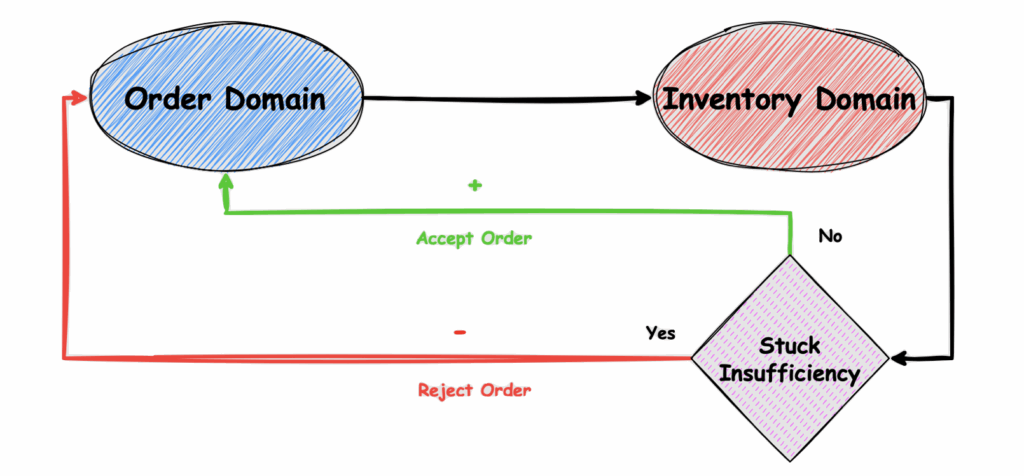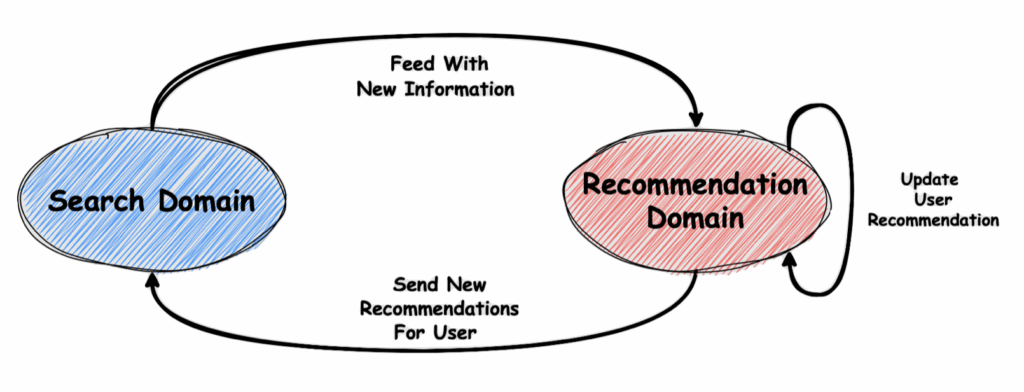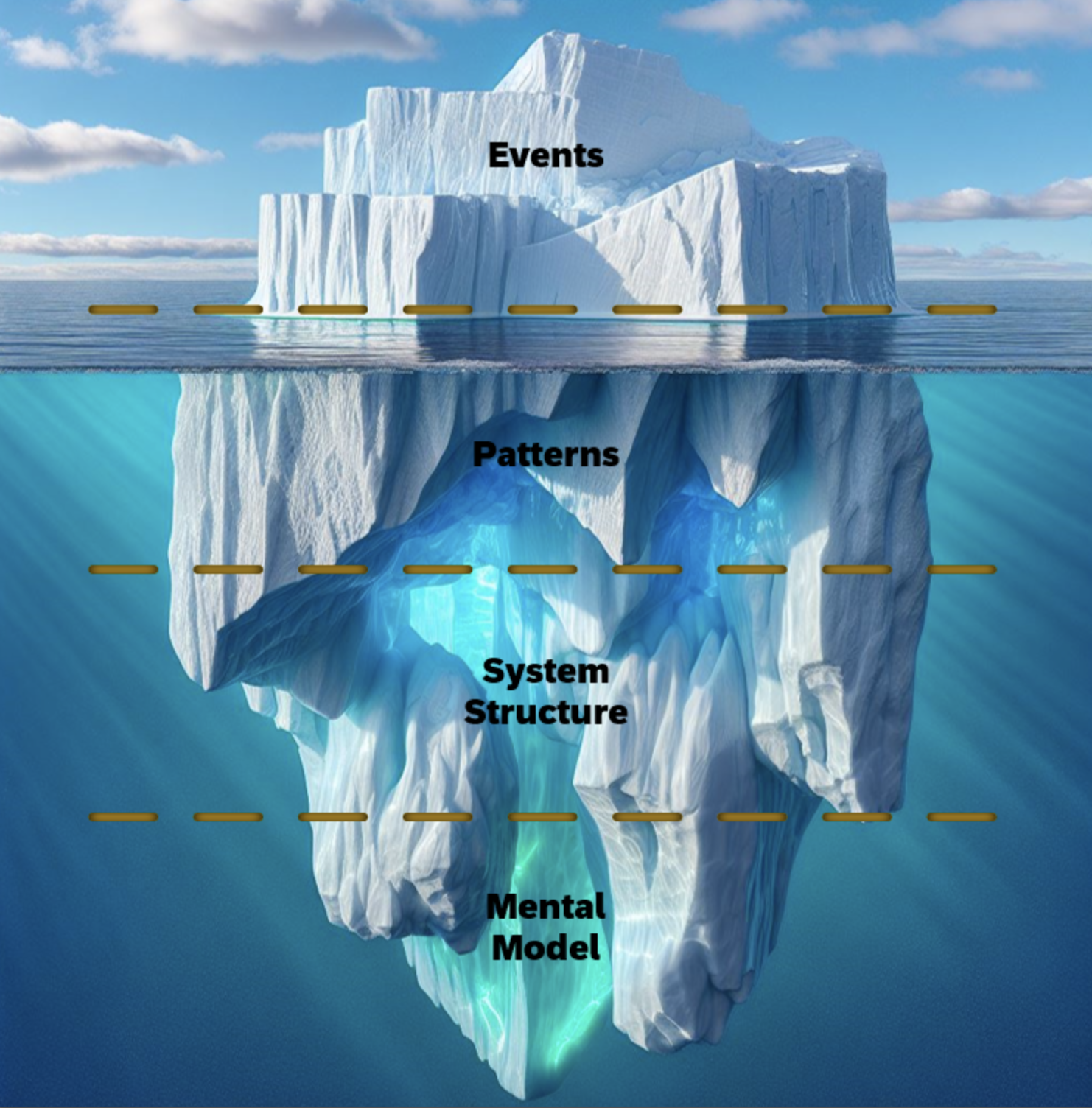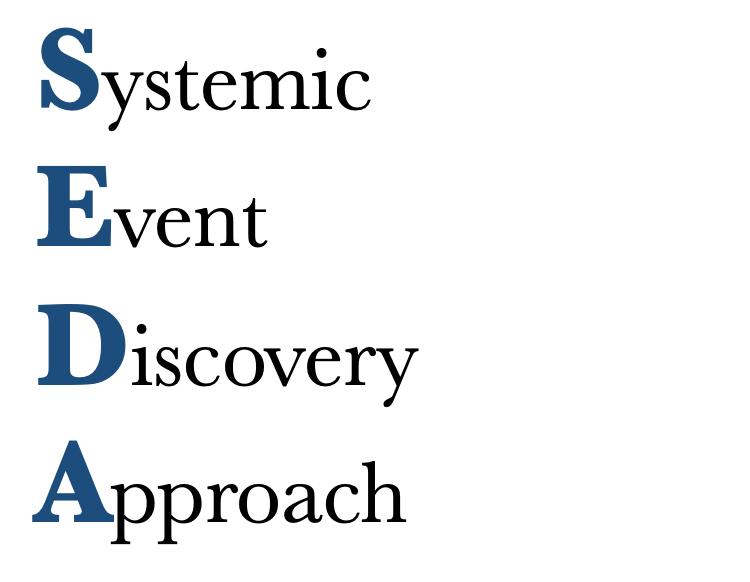Systems Thinking1 is an approach to problem-solving that views problems as part of a wider, interconnected system. Rather than isolating individual components, systems thinking considers the relationships and interactions between different elements. It aims to understand how these connections contribute to the behavior of the system as a whole.
In this article, we will explore Systems Thinking and its most relevant tool, the Iceberg Model, which enables us to analyze systems dynamically and non-linearly.
Thinking in Systems
Thinking in Systems is about looking at complex systems as a whole instead of focusing on individual parts in isolation. It helps us, as developer and architect, recognize patterns, anticipate outcomes, and design better solutions by understanding how different elements interact and influence each other, both in positive and negative way.
Instead of seeing only how A causes B, you’ll begin to wonder how B may also influence A, and how A might reinforce or reverse itself2.
When it comes to software development, this approach is important for building scalable, maintainable, and efficient architectures. It enables us to analyze applications as dynamic systems with interconnected parts and components rather than just a collection of separate functions or modules.
Parts of a Software System
A complete software system is made up of three main components, described below.

Elements or Components
Elements are the basic building blocks of any system. In software systems, these elements typically include:
- Code-base: This includes the core components like classes, functions, modules, and APIs that make up the software’s logic.
- Databases: Systems used to store and manage data, such as SQL databases, NoSQL solutions, and in-memory stores.
- Services: The application and back-end services that deliver the system’s features and handle processing tasks.
- Infrastructure: The underlying resources, like servers, cloud platforms, and networking tools, that keep everything running.
- Users: The people who interact with the system, whether they’re customers, administrators, or other stakeholders.
- External Systems: Third-party services and integrations that extend the system’s functionality or connect it with other platforms.
Each element has its own unique role in keeping the system running smoothly and efficiently.

Interconnections & Relationships
Interconnections & Relationships describe how different parts of a system work together and communicate. These can take several forms, including
- Data Flow: How information moves between components or modules.
- APIs & Interfaces: Tools and structures that allow different services to talk to each other.
- Dependencies: When one part of the system depends on another to function properly.
- Networking: The communication layer, including things like HTTP requests, message queues, or WebSockets.
Remember, poorly designed interconnections can result in tight coupling, making systems difficult to maintain and scale effectively.

Purpose or Goal
Every software system is designed with a specific purpose that guides its development. In software, this purpose may include:
- A web application that serves up dynamic, interactive content
- A cloud service built to handle massive-scale computations
- An AI model designed to make predictions based on the data it receives
The system’s objectives define its architecture, technology stack, and operational requirements.
Key Features of Systems Thinking
Besides the three core components, software system thinking also considers 3 main features that describes the behavior of system in holistic manner.
Feedback Loop
Feedback loops play a important role in shaping system behavior by adjusting operations based on the outcomes generated.
- Positive Feedback Loop
- Negative Feedback Loop
Negative Feedback Loops
Negative feedback loops serve to stabilize the system, like rate limiting used to prevent excessive API usage. They provide strategic value by enhancing resilience, ensuring predictability, and building confidence in a system’s ability to self-correct.
This diagram shows a Negative Feedback Loop between two domains: the Order Domain and the Inventory Domain. The purpose of this loop is to keep the system stable by making sure it doesn’t try to process orders that can’t be fulfilled.

In the figure above which describes a Negative Feedback Loop, the Order Domain initiates a request to place an order. Then Inventory Domain then checks if there’s enough stock available. If the stock is insufficient, the process moves into a Stuck Insufficiency state. At this point, the system notifies the Order Domain to reject the order.
Positive Feedback Loops
Positive Feedback Loop amplifies a trend, such as recommendation algorithms that enhance suggestions based on user interactions.
This diagram shows a Positive Feedback Loop between the Search Domain and the Recommendation Domain. In this loop, user behavior and system responses constantly influence each other, reinforcing and amplifying both personalization and engagement.

In the figure above which describes a Negative Feedback Loop, when a user starts a search in the Search Domain, their input is captured. Then the Recommendation Domain analyzes this new search activity. Based on the latest data, updated recommendations are sent back to the Search Domain. This ongoing interaction feeds back (Positive Feedback) into the system, helping it learn and continuously improve its recommendations over time.
System Boundaries
Clearly defining System Boundaries is crucial for understanding what lies within the system (controllable elements) and what exists outside (external dependencies, third-party APIs, external regulations). This approach aligns with the concept of bounded contexts in Domain-Driven Design when analyzing the system from a DDD perspective.
Emergent Behavior
Sometimes, software systems behave in unexpected ways. Even if those behaviors weren’t intentionally programmed. These can include things like:
- Performance issues when too many users are active at once
- Unexpected interactions between different services or components
- Security gaps caused by complex or poorly understood dependencies
Iceberg Model
The Iceberg Model is a tool used within Systems Thinking to illustrate how events are often just the visible tip of the iceberg, while deeper levels of understanding lie below the surface. The model consists of four layers:
- Events
- Patterns
- Systemic Structures
- Mental Models
By using the Iceberg model, systems thinkers can identify and address the deeper factors that contribute to observed events. Rather than focusing solely on immediate issues, they aim to shift systemic structures or change mental models to create more profound and long-lasting improvements. This model consists of 4 layers.


Events
The top layer represents Events, which are the immediate, visible occurrences or symptoms that we can observe. These are the specific incidents or outcomes that often grab our attention and demand action. While events are easy to notice, they are just the surface-level manifestations of deeper, less visible dynamics within a system.
Events in software ecosystems can take many forms, often signaling the need for immediate troubleshooting or reactive action. Common examples include:
- A noticeable drop in application performance
- A sudden spike in server load
- A user encountering an error message
However, focusing solely on events without understanding their underlying causes can lead to short-term fixes rather than sustainable solutions. To effectively manage and improve software systems, it is essential to look beyond the events and explore the patterns and structures that drive them.

Patterns
Patterns, which are trends or recurring behaviors that emerge over time are under events. By looking beyond individual events, we can identify patterns that provide insight into the system’s behavior over a longer period. Understanding these recurring behaviors allows us to anticipate future events, which helps in making more informed decisions. Patterns in the Iceberg Model helps to:
- Uncover deeper insights into software systems by revealing trends in performance
- User behavior
- Recurring issues
By analyzing patterns, software teams can identify inefficiencies, bottlenecks, or emerging risks before they escalate into critical problems.
For instance, recurring system down-times or repeated user complaints about a particular feature might indicate underlying design flaws or technical debt. Recognizing these trends allows teams to implement proactive improvements, optimize workflows, and enhance system resilience, leading to more sustainable and efficient software development.

System Structure
System Structure involves the underlying structures, rules, or mechanisms that shape the patterns we observe. These include physical structures, policies, resource flows, feedback loops, and incentives that influence behavior within the system. Furthermore, they explain why patterns emerge. By changing these structural elements, we can alter patterns and achieve different outcomes.
In software systems, System Structure is like the foundation and framework that shape how everything works together. It includes things like the architecture, data flow, APIs, and security rules that keep the system running smoothly. It also involves feedback loops, like error logs, performance tracking, and user analytics, that help teams understand what’s working and what’s no

Mental Models
The deepest layer, Mental Models, consists of the beliefs, assumptions, and values that inform the structures within a system. These mental models shape how individuals and organizations perceive problems and make decisions, influencing the design of policies and structures. Addressing issues at this level involves challenging and shifting these assumptions and values, which can lead to fundamental changes in the system.
At this level, transformation is often slow and requires deep reflection, as mental models are ingrained through experience, culture, and education. In software development, these underlying beliefs influence everything from architectural choices to team collaboration and user experience priorities. For example, a team that unconsciously values speed over maintainability may consistently prioritize rapid delivery, leading to technical debt.
Wrapping Up
Systems Thinking, when combined with the Iceberg Model, provides a robust framework for understanding and addressing the complexities of software systems.
The Iceberg Model emphasizes that visible issues represent only a fraction of the underlying complexity. In the realm of software development, these surface-level challenges often stem from deeper, less obvious patterns, structures, and systemic causes.
In software development, the Iceberg Model promotes a shift from short-term problem-solving to long-term strategic thinking. While developers may initially notice symptoms like slow performance or faulty features, Systems Thinking allows them to identify deeper systemic factors, such as flawed architecture, communication breakdowns between components, or workflow bottlenecks.

- Systems Thinking expands our tool sets as knowledge workers. It steps us outside the constant, pointless culture war about architecture versus engineering as a practice. Diana Montalion, Learning Systems Thinking ↩︎
- Donella Meadows, Thinking in Systems ↩︎




